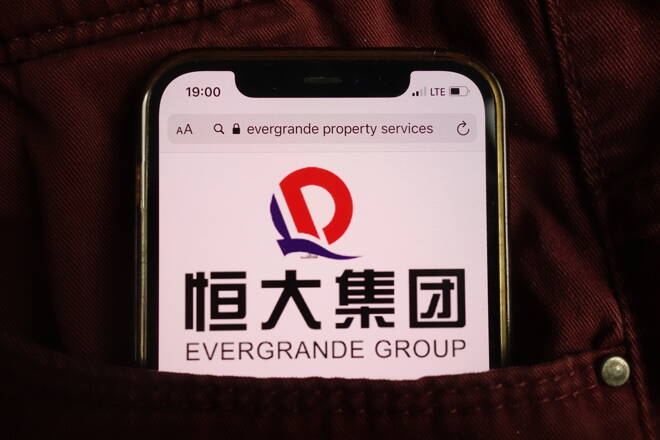Advertisement
Advertisement
Evergrande Crisis: Financial Instability Containable at Risk of Slightly Slower Growth
By:
The Evergrande crisis will have unavoidable knock-on effects as China accounts for a large portion of global growth but Beijing’s commitment to reducing high leverage in China’s corporate sector should not trigger a systemic financial crisis.
The impact of the current crisis involving the Evergrande Group on European banks ought to be more restricted, although UK banks account for more than a quarter of foreign bank claims on Chinese residents.
The expected default of the Evergrande Group is a reflection of China’s deliberate attempts in enhancing financial-system discipline. While the possibility for an escalation to a more widespread credit crisis cannot be fully excluded, we currently consider such severe form of contagion to be unlikely. The international fallout should therefore be more contained beyond the impact of less vibrant Chinese growth on the global economy.
As China’s growth should account for nearly a third of global growth this year, the impact of Evergrande will filter through to activity in Europe and the United States, among regions of the world where trade links with China are the strongest, in addition to weighing on global investor sentiment and heightening financial market volatility.
Weakness in China’s property sector has already curbed domestic economic activity for 2021. Scope revised down in July its growth expectations for China to 8.6% for 2021 from an earlier projection of 9.3%.
Beijing’s efforts in deflating domestic credit and asset price bubbles were never likely to be a smooth process. The approach towards Evergrande is consistent with efforts in forcing deleveraging in the sector and more credit defaults are likely to follow with time.
Real-estate companies of China have tapped the public US dollar bond market for USD 274bn over the past five years, according to Bond Radar data. Of this, roughly USD 215bn remains outstanding from roughly 120 companies, predominantly owed by sub-investment grade borrowers. Many said issuers have developed a programmatic borrowing approach so have multiple credit lines outstanding. Some USD 10bn falls due between now and the end of this year followed by another roughly USD 50bn in 2022.
Chinese banks, insurance companies and bond funds have provided significant funding over recent years and Chinese banks’ large exposures to the domestic property sector are among more significant risks facing China’s financial system. In response to this evolving crisis, some banks have started to increase loan loss provisioning while others are prepared to roll over their existing loans.
The heavy bias towards Chinese banks and securities firms in underwriting groups suggests limited exposure by international investors on aggregate to Chinese US dollar-denominated real estate debt. Indeed, initial placement data where this was made available at time of issuance mainly display single-digit percentages of order books allocated to EMEA/US accounts, the majority being parked with Chinese financial institutions.
The effect of the crisis on European banks is likely to be more limited as the latter appear to have limited exposure to Chinese property developers, certainly relative to aggregate assets.
However, next to higher credit loss charges, there will be further negative spill-over through banks’ Asian capital markets operations, asset management and private banking, as well as from lending to property-related sectors, such as in the materials sector. These impact P&L of Europe’s globally active banks over coming quarters as could the ongoing regulatory crackdown by China’s authorities. According to the Bank for International Settlements, UK banks are the most exposed, accounting for 27% of USD 917bn in foreign bank claims on Chinese residents as of Q1 this year.
The prospect of bailouts from local governments or regulators has generally been factored in credit risk assessments. Recent policy changes and a contemporary higher tolerance for corporate defaults by Chinese authorities are forcing, however, investors and lenders to re-assess credit risk on their loan books.
To tackle moral hazard risk in the real estate sector, authorities are likely to tolerate a market correction provided there are no clear signals of more widespread systemic risk. However, large off-balance sheet exposures, often involving a range of non-bank financial institutions, increase uncertainty concerning how any crisis such as this one might spread across the wider, opaque Chinese financial system. Should liquidity shortages in developers lead to widespread fire-sales within portfolios, resulting financial distress could become more difficult to restrain.
Chinese authorities will need to tread carefully between reducing indebtedness among highly levered developers, which is likely to include tolerating further managed default instances, and avoiding the very hard landing they are aiming to prevent. If managed successfully, China’s efforts in reducing excessive leverage and moral hazard can help to stabilise the financial system longer term. Indeed, this ongoing transition and maturation of the Chinese financial system anchored a revision of the sovereign credit Outlook of China to Stable, from Negative, in July.
For a look at all of today’s economic events, check out our economic calendar.
Eiko Sievert is a Director in Sovereign and Public Sector ratings at Scope Ratings GmbH. Dierk Brandenburg, Managing Director at Scope Ratings in Financial Institutions, contributed to writing this commentary
About the Author
Eiko Sievertcontributor
Eiko Sievert is an Executive Director in Scope’s Sovereign & Public Sector ratings group, responsible for ratings and research on a number of public-sector borrowers.
Advertisement
